Please help to answer boxes. Will give a really good review and thumbs up!
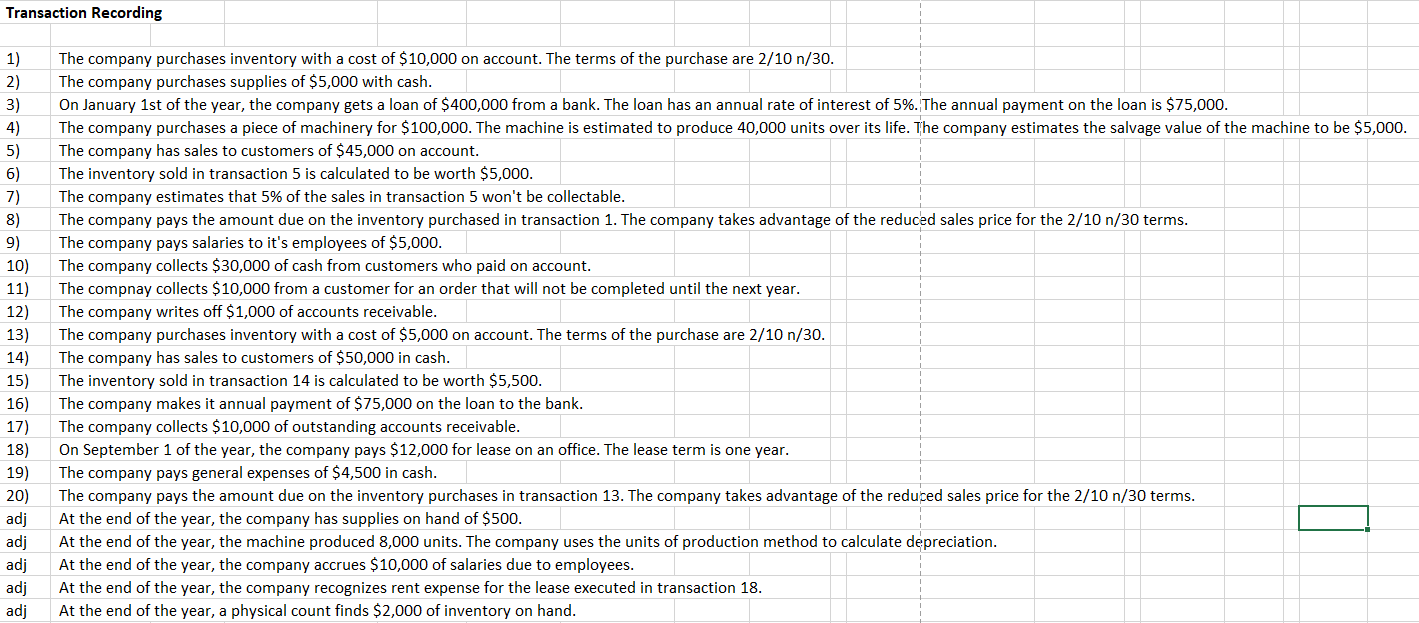
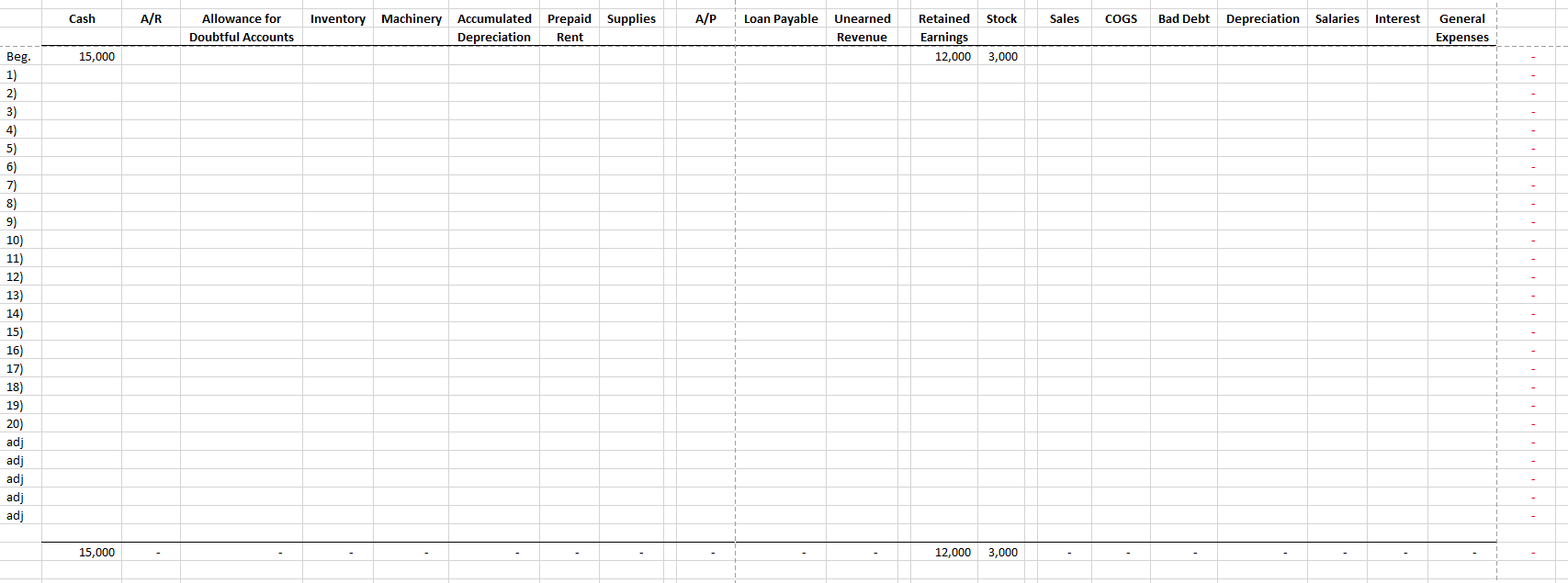
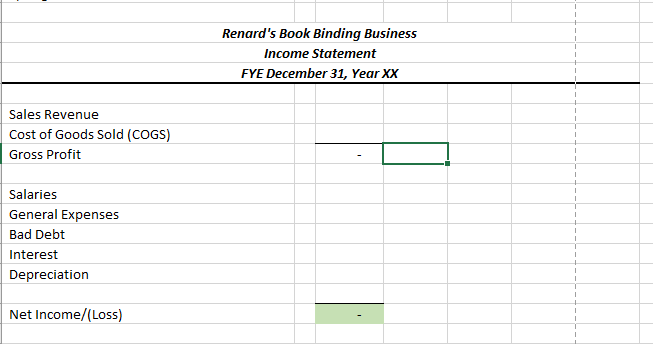
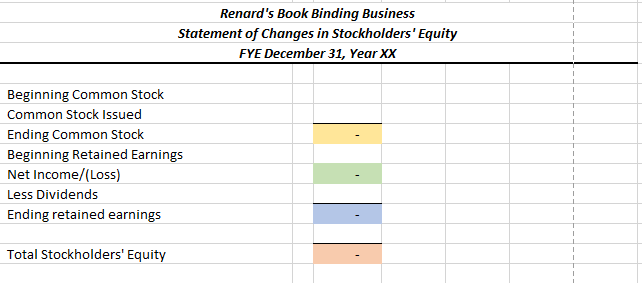
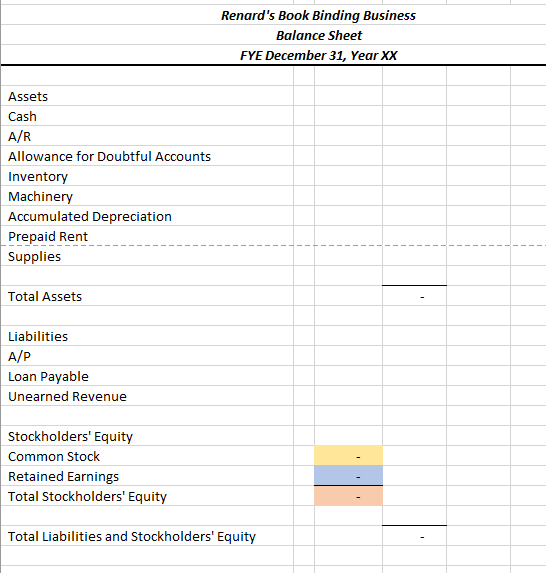
Transaction Recording 1) 2) 3) 4) 5) 6) 7) 8) 9) 10) 11) 12) 13) 14) 15) 16) 17) 18) 19) 20) adj adj adj adj adj The company purchases inventory with a cost of $10,000 on account. The terms of the purchase are 2/10 n/30. The company purchases supplies of $5,000 with cash. On January 1st of the year, the company gets a loan of $400,000 from a bank. The loan has an annual rate of interest of 5%. The annual payment on the loan is $75,000. The company purchases a piece of machinery for $100,000. The machine is estimated to produce 40,000 units over its life. The company estimates the salvage value of the machine to be $5,000. The company has sales to customers of $45,000 on account. The inventory sold in transaction 5 is calculated to be worth $5,000. The company estimates that 5% of the sales in transaction 5 won't be collectable. The company pays the amount due on the inventory purchased in transaction 1. The company takes advantage of the reduced sales price for the 2/10 n/30 terms. The company pays salaries to it's employees of $5,000. The company collects $30,000 of cash from customers who paid on account. The compnay collects $10,000 from a customer for an order that will not be completed until the next year. The company writes off $1,000 of accounts receivable. The company purchases inventory with a cost of $5,000 on account. The terms of the purchase are 2/10 n/30. The company has sales to customers of $50,000 in cash. The inventory sold in transaction 14 is calculated to be worth $5,500. The company makes it annual payment of $75,000 on the loan to the bank. The company collects $10,000 of outstanding accounts receivable. On September 1 of the year, the company pays $12,000 for lease on an office. The lease term is one year. The company pays general expenses of $4,500 in cash. The company pays the amount due on the inventory purchases in transaction 13. The company takes advantage of the reduced sales price for the 2/10 n/30 terms. At the end of the year, the company has supplies on hand of $500. At the end of the year, the machine produced 8,000 units. The company uses the units of production method to calculate depreciation. At the end of the year, the company accrues $10,000 of salaries due to employees. At the end of the year, the company recognizes rent expense for the lease executed in transaction 18. At the end of the year, a physical count finds $2,000 of inventory on hand. Cash A/R A/P Sales COGS Bad Debt Depreciation Salaries Interest Allowance for Doubtful Accounts Inventory Machinery Accumulated Prepaid Supplies Depreciation Rent Loan Payable Unearned Revenue Retained Stock Earnings 12,000 3,000 General Expenses 15,000 Beg. 1) 2) 3) 5) 6) 7) 8) 9) 10) 11) 12) 13) 14) 15) 16) 17) 18) 19) 20) adj adj adj adj adj 15,000 12,000 3,000 Renard's Book Binding Business Income Statement FYE December 31, Year XX Sales Revenue Cost of Goods Sold (COGS) Gross Profit Salaries General Expenses Bad Debt Interest Depreciation Net Income/(Loss) Renard's Book Binding Business Statement of Changes in Stockholders' Equity FYE December 31, Year XX Beginning Common Stock Common Stock Issued Ending Common Stock Beginning Retained Earnings Net Income/(Loss) Less Dividends Ending retained earnings Total Stockholders' Equity Renard's Book Binding Business Balance Sheet FYE December 31, Year XX Assets Cash A/R Allowance for Doubtful Accounts Inventory Machinery Accumulated Depreciation Prepaid Rent Supplies Total Assets Liabilities A/P Loan Payable Unearned Revenue Stockholders' Equity Common Stock Retained Earnings Total Stockholders' Equity Total Liabilities and Stockholders' Equity Transaction Recording 1) 2) 3) 4) 5) 6) 7) 8) 9) 10) 11) 12) 13) 14) 15) 16) 17) 18) 19) 20) adj adj adj adj adj The company purchases inventory with a cost of $10,000 on account. The terms of the purchase are 2/10 n/30. The company purchases supplies of $5,000 with cash. On January 1st of the year, the company gets a loan of $400,000 from a bank. The loan has an annual rate of interest of 5%. The annual payment on the loan is $75,000. The company purchases a piece of machinery for $100,000. The machine is estimated to produce 40,000 units over its life. The company estimates the salvage value of the machine to be $5,000. The company has sales to customers of $45,000 on account. The inventory sold in transaction 5 is calculated to be worth $5,000. The company estimates that 5% of the sales in transaction 5 won't be collectable. The company pays the amount due on the inventory purchased in transaction 1. The company takes advantage of the reduced sales price for the 2/10 n/30 terms. The company pays salaries to it's employees of $5,000. The company collects $30,000 of cash from customers who paid on account. The compnay collects $10,000 from a customer for an order that will not be completed until the next year. The company writes off $1,000 of accounts receivable. The company purchases inventory with a cost of $5,000 on account. The terms of the purchase are 2/10 n/30. The company has sales to customers of $50,000 in cash. The inventory sold in transaction 14 is calculated to be worth $5,500. The company makes it annual payment of $75,000 on the loan to the bank. The company collects $10,000 of outstanding accounts receivable. On September 1 of the year, the company pays $12,000 for lease on an office. The lease term is one year. The company pays general expenses of $4,500 in cash. The company pays the amount due on the inventory purchases in transaction 13. The company takes advantage of the reduced sales price for the 2/10 n/30 terms. At the end of the year, the company has supplies on hand of $500. At the end of the year, the machine produced 8,000 units. The company uses the units of production method to calculate depreciation. At the end of the year, the company accrues $10,000 of salaries due to employees. At the end of the year, the company recognizes rent expense for the lease executed in transaction 18. At the end of the year, a physical count finds $2,000 of inventory on hand. Cash A/R A/P Sales COGS Bad Debt Depreciation Salaries Interest Allowance for Doubtful Accounts Inventory Machinery Accumulated Prepaid Supplies Depreciation Rent Loan Payable Unearned Revenue Retained Stock Earnings 12,000 3,000 General Expenses 15,000 Beg. 1) 2) 3) 5) 6) 7) 8) 9) 10) 11) 12) 13) 14) 15) 16) 17) 18) 19) 20) adj adj adj adj adj 15,000 12,000 3,000 Renard's Book Binding Business Income Statement FYE December 31, Year XX Sales Revenue Cost of Goods Sold (COGS) Gross Profit Salaries General Expenses Bad Debt Interest Depreciation Net Income/(Loss) Renard's Book Binding Business Statement of Changes in Stockholders' Equity FYE December 31, Year XX Beginning Common Stock Common Stock Issued Ending Common Stock Beginning Retained Earnings Net Income/(Loss) Less Dividends Ending retained earnings Total Stockholders' Equity Renard's Book Binding Business Balance Sheet FYE December 31, Year XX Assets Cash A/R Allowance for Doubtful Accounts Inventory Machinery Accumulated Depreciation Prepaid Rent Supplies Total Assets Liabilities A/P Loan Payable Unearned Revenue Stockholders' Equity Common Stock Retained Earnings Total Stockholders' Equity Total Liabilities and Stockholders' Equity











